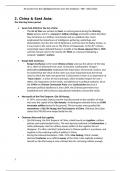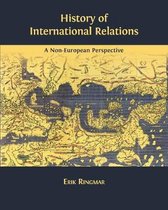All words from the highlighted boxes from the textbook—HIR—2022-2023
2. China & East Asia:
The Warring States period
Sunzi (544-496CE) & The Art of War:
- The Art of War was written by Sunzi, an active general during the Warring
States period, and it’s a manual of military strategy and tactics which describes
how to behave as a military commander and as a political ruler. Sunzi
emphasized the importance of intelligence gathering, subterfuge and
dissimulation, but also the role of diplomacy, and how best to deploy troops, so
it was much in the same way as The Prince of Maquiavelo. In the 20th century,
surprisingly Japan defeated Russia in a battle in the Russo-Japanse War in 1905
and this manual came to be read by the West as a manual embodying a
uniquely “eastern” warfare.
Kongzi AKA Confucius:
- Kongzi (Confucius) is the most Chinese scholar and was the adviser of the king
of Lu. After his dismissal from court, he became a philosopher. Kongzi’s
philosophy Confucianism emphasized the importance of personal conduct, and
he insisted that the virtue of the rulers was more important than the formal
rules by which the state was governed. Confucianism is seen as an expression of
“Asian values”, a series of moral precepts, which included respect for one’s
elders, the importance of the family, and deference to political authority. Since
the 1990s the Chinese Communist Party uses Confucianism because it
promotes political obedience & since 2004, the Chinese government has
established over 300 Confucius educational institutions around the world.
Necropolis of the First Emperor: Qin Shi Huang:
- In 1974, a terracotta Chinese warrior was discovered on the outskirts of what
was once the capital of the Qin dynasty. Archeologists estimate there are 8.000
terracotta soldiers buried in the ground. This terracotta army guarded the
mausoleum of Qin Shi Huang; the First Emperor of China. Historian Sima Qian
states that 700.000 men helped build the site.
Chairman Mao and the Legalists
- Qin Shi Huang, the First Emperor of China, relied heavily on Legalism: ruthless
policies and underhanded tactics. The next dynasty switched to Confucianism, a
softer philosophy. But the ruthless power politics of the Legalists did not
disappear. It’s often said that Confucianism in Chinese politics is a pretense, and
Legalism is the enduring reality of politics in China.
- During the Cultural Revolution, 1966–1976, Mao Zedong, China’s leader,
declared Confucius as an official enemy of the state. Mao explicitly modeled
himself on Qin Shi Huang & only criticized him for not being ruthless enough.
1
, All words from the highlighted boxes from the textbook—HIR—2022-2023
The development of the Chinese state
Sogdia & Sogdian letters
- Sogdia was a Central Asian kingdom that flourished between the 4th-9th
centuries CE. The Sogdians operated as financial intermediaries: setting up
business deals, organizing caravans, arranging for money to be transferred and
invested. Most merchants only travelled short distances, but Sogdian
communities could be found along the entire network of Asian trade routes.
The Sogdian language was the universal language of commerce across the
Eurasian landmass. In 1907, British archaeologist Aurel Stein discovered papers
in the Chinese city of Dunhuang: the Sogdian letters, dating from early in the
4th century. Unusually, the letters were not written by officials but by ordinary
people.
The Xiongnu confederation:
- The Xiongnu were a pastoral people & Mongol tribes in China, 2000 years ago.
The very first Chinese rulers made war on the Xiongnu. They were driven to
Mongolia but continued to cause trouble, so Han emperors tried to pacify them
with tributes. However, the Xiongnu asked for higher payments and in the end,
the Chinese were effectively transformed into tribute bearers to Xiongnu,
rather than the other way around. In the end, a southern group of Xiongnu
tribes defected to the imperial side. The ethnic background of the Xiongnu is
disputed: Turks, Mongols, Huns, or even Iranians.
Xuanzang & Journey to the West
- Buddhism was relatively new in China and Chinese Buddhists only had poor
translations of Buddhist texts. Enter Xuanzang, a Buddhist monk who traveled
to India in 629 CE to look for original texts from which more faithful translations
could be made. After 13 years of visiting various pilgrimage sites, teachers, and
looking for manuscripts, he returned to China in 646 & obtained the emperor’s
support in building a pagoda where the manuscripts could be stored, and an
institute was founded where the task of translation began.
- Journey to the West is a popular Chinese novel from the 16th century which
gives an account of Xuanzang’s story, told as a comic adventure that mixes
fantasy and folktales. In the novel, Xuanzang has 4 traveling companions: a
monkey, a pig, an ogre, and a white steed. Journey to the West is an allegory of
a group of pilgrims who travel together towards enlightenment, where the
success of one of them depends on the success of the others.
Zheng He, a giraffe in Beijing & Confucians restrict foreign trade
- Zheng He was a successful eunuch trader, who traveled all over by ship and
brought back treasures to China.
- In 1414 he brought a giraffe to Beijing, which was a present from Saifuddin
Hamza Shah, the ruler of Bengal. Shah wanted to impress the Chinese emperor
by giving him the giraffe. Confucian scholars were amazed and decided that the
giraffe must be a unicorn. When they learned that the animal in the Somali
2
, All words from the highlighted boxes from the textbook—HIR—2022-2023
language was known as girin, they named it qilin, the Chinese name of the
unicorn, because it sounded alike.
- A decade later, all foreign trade and travel were outlawed by imperial decree.
Restricting international trade was a way for the Confucians to impose their
outlook on the country & to enhance their power at the expense of their
opponents at court. In the end, the anti-commercial attitude of the Confucian
scholars defeated the entrepreneurial curiosity of eunuchs like Zheng He.
The Great Wall of China does not exist
- The Great Wall of China doesn’t exist & cannot be seen from space. There are
many gaps and some walls run parallel to each other, so it’s impossible to know
how long the Wall is. The Great Wall of China is a European invention: it was
built in the minds of European readers because of the letters from Jesuit
missionaries in China. To generate support for their missionary project, they
told of the most wonderous thing China had: the Great Wall. European visitors
insisted on being shown the attraction. When the Communists came to power
in 1949, they adopted the European idea of the Great Wall as a national
emblem, and a symbol of China’s independence and self-reliance.
Chinese pirates in Taiwan: Koxinga (1624–1662)
- Born in Japan, Koxinga (1624–1662) AKA Zheng Chenggong, was a scholar, a
pirate, and a Ming loyalist. Koxinga fought for the Ming cause when Manchu
tribes took over China in 1644 & established Qing dynasty. He managed to
destroy the Qing navy & fled to the island of Taiwan, which was controlled by
the Dutch East India company. He was seen as an outlaw and pirate by the new
Chinese regime. When he arrived in Taiwan, he defeated the Europeans but
died a year later from malaria in the Philippines. In 1683 the Qing army
defeated Koxinga’s descendants & claimed Taiwan as a part of the Chinese
empire.
- When Mao rose to power in China, the Chinese nationalists fled to Taiwan.
- Today, Taiwan remembers Koxinga as a hero & those who want independence
from China say that Koxinga turned the island into a self-governing territory.
The original inhabitants of Taiwan don’t like Koxinga because his occupation of
the island ended their lucrative trade with the Dutch.
- China is wrong to insist Taiwan is part of China. First, there were only aborigines
on the island, then Portuguese, the Spaniards, and the Dutch. Only after that
came the Chinese — and Koxinga, in the latter part of the 18th century, was the
first Chinese ruler of the island.
Treaties with the Russians: Treaty of Nerchinsk
- When Russia had conquered all of China in the 1680s, the Manchus decided to
deal with them. In 1685 the Chinese forced them to back off & concluded a
treaty in 1689: Treaty of Nerchinsk. It established a common border between
Russia & China. In exchange for territorial concessions, the Russians obtained
access to Chinese markets and the right to establish a Russian church in Beijing.
- The official version of the Treaty of Nerchinsk was written in Latin, with Russian
and Manchu translations. There was no official Chinese text, and there were no
3
, All words from the highlighted boxes from the textbook—HIR—2022-2023
Confucian scholars present at the negotiations. Throughout the talks, the
Chinese treated the Russians with a surprising amount of respect: the treaty
itself made no reference to the Russians as tribute bearers.
- A further treaty between China and Russia was signed at Kyakhta in 1727. Here,
the earlier border was confirmed, and new borders were drawn up which
separated Mongolia (under Chinese control) from Russia.
Yuanmingyuan: a Disneyland for one person
- In the Qing dynasty, Yuanmingyuan was an enclosed palace compound with a
large pleasure garden and the location of an imperial archive and library. It
resembled a theme park intended for the amusement of the emperor of China,
his women, children, and the eunuch courtiers who attended to their needs.
- In 1860, British and French troops looted Yuanmingyuan & the highest-ranking
British leader of the mission James Bruce burned the compound to the ground.
The Europeans did this to “civilize” the Chinese because China had isolated
itself and failed to keep up with world events. By waging war on the Chinese,
they were going to force them to open up to the world market and to
influences from abroad.
George Macartney at Qianlong’s court & Ketou
- The Chinese tribute system included European countries, but the Chinese were
very reluctant to grant them access. Trade was only allowed in one city, but the
British regarded this as an unacceptable affront. They dispatched a series of
embassies to Beijing to try to convince the emperor to open up the country to
their merchants.
- The most famous embassy was led by George Macartney in 1792. Macartney
made the 6-month journey loaded with samples of British-made goods and with
presents for the emperor. Once they arrived in Beijing, the British were
required to go through the same ceremony as all tribute bearers. This included
the ketou, the “three prostrations, and knockings of the head,” which was the
traditional way in which visitors showed their submission to the imperial
throne. Macartney refused to go through with the ritual because it reeked of
religious worship & it was degrading to Britain and himself. The British were
told that if they refused to ketou they might as well go home. They never got a
trade deal with China.
The overland system
Khotan & Xinjiang & Uyghurs
- 2000 years ago, a Buddhist kingdom, Khotan, was established in China. The
caravan trade made Khotan prosperous & they were devout Buddhists. Some
spoke Chinese, others Tibetan and Indian languages. In 1006, the Khotan
Kingdom fell to Muslim invaders.
- Now it’s Xinjiang an “autonomous” region bordering Kazakhstan and other
Central Asian countries. Its population is 43% Uyghur, 41% Han Chinese & the
remainder are Kazakhs and other ethnic groups. It was conquered in 1759, and
since 1884 Xinjiang came to constitute a Chinese province.
4





